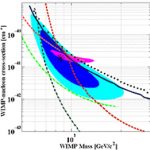Scientists around the world are trying to understand the nature of dark matter, which accounts for most of the mass of the universe. The earth seems to be moving through a cloud of dark matter particles that encompasses the visible parts of our galaxy. We should be able to sense this dark matter, if we… More »
Highlights
The Fermi bubbles extend tens of thousands of light years north and south of the Galactic Center—the center of the Milky Way—and are likely the consequence of a very active period in the recent history of the galaxy, maybe having to do with the rate of star formation in the inner galaxy or with an… More »
After getting the first light in the mid of Sept., 2012, the DES team is flashing forward at amazing speed. By the end of 2012, we have successfully completed the commissioning and science verification, and the formal survey will start at the beginning of 2013. During the first of the five survey seasons, DES is… More »
The cryostat and time projection chamber for the SCENE experiment (SCintillation Efficiency of Noble Elements) were recently installed at the FN Tandem Van de Graaff Accelerator at the University of Notre Dame. Neutrons emitted from a lithium-fluoride target produce recoiling argon nuclei – the same signature expected for Weakly Interacting Massive Particles – in the… More »
The Dark Energy Survey (DES) will use its newly constructed camera, DECam, to observe a large swath of the southern sky out to vast distances in order to provide new clues about the nature of dark energy or why the universe’s expansion is accelerating. The DECam imager was designed and built at Fermilab over the… More »
This month is an important one for the COUPP-60 detector. In the race to detect dark matter, experimentalists want to go deeper and get bigger, and with COUPP-60, the COUPP collaboration is hoping to do just that. For the past two years, the COUPP-4 detector containing about 4 kg of target has been running 6800… More »
Eight billion years ago, rays of light from distant galaxies began their long journey to Earth. That ancient starlight has now found its way to a mountaintop in Chile, where the newly constructed Dark Energy Camera, the most powerful sky-mapping machine ever created, has captured and recorded it for the first time. That light may… More »
Not long ago the Chameleon Afterglow Search (CHASE) reported its results on a search for a candidate dark energy particle. While those results did not report a “chameleon” afterglow signal, it did report an afterglow signal—the “orange glow”. A significant amount of additional data was taken to characterize this orange glow, its color, temperature dependence,… More »
The Pierre Auger Observatory located in Argentina is designed to observe high energy cosmic rays. Fortuitously, the Observatory is able to search for high energy neutrinos where its detection capabilities are comparable to that of neutrino-dedicated observatories. Due to the small cross section, neutrino-induced air showers are likely to occur deep in the atmosphere. Hence,… More »
The COUPP Collaboration uses bubble chambers to search for dark matter. The experiment works because the fluid in the detector is in a “superheated” state – the fluid wants to boil but needs something to give it the extra heat to make a bubble. Particle interactions with neutrons, alphas or potentially dark matter can give… More »










